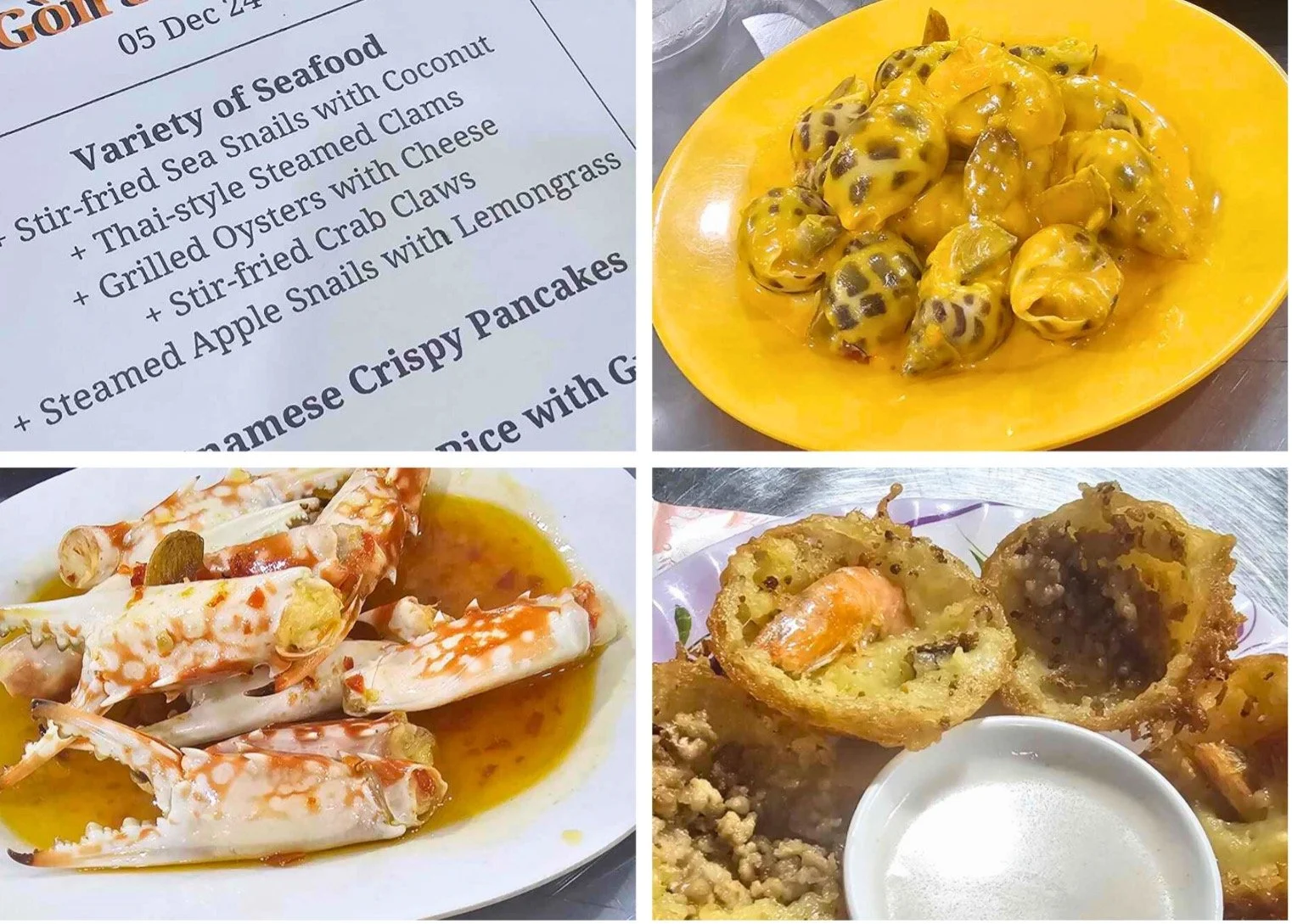Ni Sa Bula to Xin Chào: Exploring Vietnam’s Food Culture Through a Fijian Lens"
DISCOVERING VIỆT NAM THROUGH ITS VIBRANT FOOD by Manaini Marama Cama (Fiji) Nasau, Moce, Lau, vasu i Nailaga, Ba
Xin chào! Ni sa bula and warm greetings from Bình Thạnh District, one of the vibrant 22 districts in Hồ Chí Minh City, the bustling financial hub and most populous city of Việt Nam. Two weeks ago, I arrived here alongside 14 incredible Pacific women, and every day since has been a journey filled with growth, discovery, and unforgettable firsts
Việt Nam, the rising star of Asia, captivates with its stunning landscapes, majestic rivers, and rich history that tells a story of resilience, perseverance, growth and culture. This Southeast Asian marvel, home to over 98 million people, is picturesque and a paradise for food; it is no wonder Việt Nam is celebrated for its vibrant and diverse cuisine.
Việt Nam feels worlds away from the familiar comforts of my homes - Nadi, Fiji, and Wellington, Aotearoa New Zealand. Having never set foot in an Asian country before, I felt nervousness, curiosity, and excitement as I prepared for this adventure. I have often been told of my 'limited palate', always going with things I know or am familiar with. I now laugh at my younger sisters' ask before the trip: "… promise you'll try the food!"; she even sent me TikTok videos of travellers raving about their culinary experiences, her way of helping 'limited palate' me prepare for the Vietnamese food experience.
The culinary experience in Việt Nam has been nothing short of remarkable. What surprised me was that the cuisine and food culture reminded me so much of home, Fiji. The use of different flavours, seafood and greens reminded me of the food I grew up with. I shared the photos of my first meal here, gỏi cuốn, DIY fresh spring rolls, with my family; it had a lot of leafy greens. My Ta (father) recognised all the greens and gave their iTaukei Fijian names, followed by the typical Fijian dad remark, "... eat a lot of that". Another notable and heartwarming similarity is the communal joy of sharing meals, which is also part of Fijian culture and other cultures across the Pacific. As I reflect on and share this experience, I am grateful and reminded of how food has the power to bridge worlds, creating a sense of belonging in unfamiliar places and weaving together the threads of culture, family, and home.
Adventure
Việt Nam offers an extraordinary range of culinary delights, from bustling street food carts to restaurants. Every meal is an experience and adventure! Vietnamese cuisine isn’t just food; it’s an experience, a story told through bowls, plates, and cups. Every dish carries different and interesting tastes—sweet, sour, salty, and umami.
Vietnamese Cuisine
How food is prepared and presented is also diverse, reflecting the rich history and diversity in the different regions in Việt Nam. Food is grilled, steamed, stir-fried, simmered or wrapped and cooked in leaves (another similarity of how food is prepared in Fiji). Meals are usually accompanied by fresh herbs, sauces, and pickled condiments to elevate the meal. Whatever the cooking method, the result is a cuisine that feels light and healthy yet flavourful and indulgent.
One thing in Việt Nam that instantly reminds me of Fiji is the incredible variety of fruits. Here, we’ve been spoiled with an abundance of guava, kavika (iTaukei Fijian word for Malay rose apple), watermelon, mangoes, pawpaw, and bananas. Many of these fruits are also blended into refreshing juices or smoothies. The freshness and taste are comforting, reminding me of home.
Vietnamese Coffee
And then there's coffee! Vietnam's coffee culture is nothing short of extraordinary—an eye-opening revelation that redefines what coffee can be. Việt Nam is one of the world's largest coffee producers, renowned for its robusta beans, which are a key export and form the foundation of the country's vibrant coffee culture. Forget flat whites and cappuccinos; here, coffee is an art form and a vibrant part of daily life. My introduction to this world came in the form of ca phe sua da, Vietnamese iced coffee made with dark, bold-roasted coffee sweetened with condensed milk. The combination was indulgent and tasty. With so many varieties and flavours to explore, experiencing most (if not all) of it is on the to-do list during my time here.
An Authentic Taste of Ho Chi Minh City’s Street Food Culture
Street Food Tour menu and dishes
As part of our orientation week, we went on a fun and incredible evening street food tour in Ho Chi Minh City. It wasn't just about sampling food; it was about immersing ourselves in the country's vibrant sights, sounds, and flavours. The tour offered an authentic taste of the city's rich culinary heritage.
Our first stop was Quán Ốc Như, a seafood haven where we experienced the Việt Nam take on fresh ocean delicacies. The spread included oysters, crabs, clams, and sea snails, each dish prepared with traditional Vietnamese flair. One dish that caught me by surprise was the sea snails. Initially apprehensive, I found them reminiscent of the sici (Cook's Turban sea snail) back in Fiji. The familiar taste evoked a sense of familiarity. The seafood was served with bread, something very different from what I am used to. This Fijian longed for some dalo/tavioka (taro/cassava) and miti (a coconut cream-based condiment) to complete the meal. We continued the tour with bánh xèo and cơm tấm. We also indulged in Vietnamese tofu pudding for dessert, a nice way to end the evening.
What truly elevated this experience was the sense of community it fostered; we were sharing food, and so was everyone else around us. Sharing these incredible dishes with a group of amazing women and having a talanoa added depth and meaning to the evening.
This food tour wasn't just a culinary adventure—it felt like a bridge connecting where I was to where I am from. It was a delicious reminder of the beauty of diversity and the universal joy of sharing food. For anyone eager to explore a culture through its cuisine, I recommend a food tour (or something similar) of local cuisine.
The Favourites
Việt Nam is a haven for food, offering an incredible variety of dishes and drinks. So when asked what the favourites were, I didn't know where to start. Narrowing down my favourites has been no easy, but here are the standouts.
Surprisingly, my favourite dish isn't one of the more famous staples, but something simpler: rau muống xào tỏi (stir-fried morning glory with garlic). This simple yet flavorful dish reminds me of qisi moca/drauni kirisi (iTaukei Fijian for sauteed spinach/watercress).
When it comes to drinks, coffee reigns supreme for me in any form. But if I had to pick a non-coffee option, it would be the Vietnamese lemongrass lemon honey tea, served cold. I've only come across it at the food and drink kiosk at my host company's office; it's a refreshing and citrusy treat with just the right touch of sweetness.
For dessert, nothing beats the fresh fruit platters here. The platters of guava, kavika, watermelon, and mangoes are a delicious and simple way to end a meal full of flavour.
The standouts: rau muống xào tỏi, Vietnamese lemongrass lemon honey tea and fruit platter.
What I’m missing in Việt Nam?
Being in Việt Nam has been a whirlwind of culinary delights, but now and then, I long for the comforting and familiar tastes of home. Nothing beats the taste of Fiji-style ika va miti—fresh fish cooked in creamy coconut milk, seasoned perfectly to bring out the taste of the ocean. And then there’s bisikete toni (cabin crackers dunked in white tea), the simple but very homely treat. And, of course, I can't forget Fiji-style curry chicken and roti. Although missing these, I remind myself that they'll all be waiting for me when I return home in late January. For now, I'm embracing every flavourful adventure Việt Nam offers and enjoying this fantastic opportunity.
What makes Vietnamese cuisine special isn’t just its vibrant flavours or varieties—it’s the sense of connection it fosters. Sharing meals here goes beyond having a meal; it’s a cultural ritual, a way to bond and connect. Whether gathered around a street food setup or a table at a restaurant, sharing food creates a sense of community that feels comforting and universal. As Pasivika, we understand this deeply. The gracious hospitality we’ve experienced in Việt Nam—where food is generously offered and joyfully shared—mirrors our traditions. It’s a beautiful reminder of how food connects us all.





